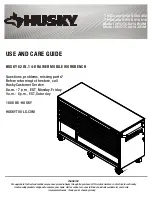
been connected, it should remain on the same channel to retain the association between the
HBA channel and World Wide identifier.
Planning the parallel SCSI configuration
The parallel SCSI libraries use the Ultra 320 SCSI LVD interface. The libraries use a separate
SCSI ID for each tape drive, with dual LUNs on the master drive's SCSI ID to control the tape
drive (LUN 0) and library robotic (LUN 1). Hewlett Packard Enterprise recommends that each
Ultrium tape drive be put on its own bus when possible.
The parallel SCSI libraries incorporate a wide SCSI-2 or SCSI-3 low-voltage differential (LVD)
SCSI bus. Make sure your SCSI host adapter or controller supports these standards.
IMPORTANT:
The libraries are NOT compatible with a high-voltage differential (HVD) SCSI
bus. Do not put the library on a narrow (50-pin) parallel SCSI bus because doing so will severely
degrade performance.
If the host computer will have multiple parallel SCSI devices, you must decide how they will be
configured into one or more parallel SCSI busses.
About parallel SCSI busses
A parallel SCSI bus consists of the host bus adapter (HBA), the parallel SCSI devices, the parallel
SCSI cables, and the terminators. The HBA and devices are connected in a chain, with each
device connected to the next. The last device must have a SCSI terminator. Each device in the
chain must have a unique SCSI address (SCSI ID).
Complex devices, such as the tape library, assign sub-addresses, called logical unit numbers
(LUNs), to different parts of the device. The HBA and operating system must support multiple
LUNs, also called LUN scanning, for the application software to operate the tape library. HPE
Smart Array controllers, most third-party RAID controllers, and many on-board SCSI controllers
do not support multiple LUNs.
An HBA might have one or two channels, with each channel supporting one parallel SCSI bus.
Check to see how many channels the HBA has and what devices are already connected to the
HBA. Some devices, such as parallel SCSI disk drives, could be inside the server.
The devices on a parallel SCSI bus share bandwidth so be careful about which devices you put
together on a bus. Also, putting a single-ended (SE) SCSI device on the bus will slow all of the
devices on the bus down to SE speed. Check each device's interface specifications to see what
kind of parallel SCSI interface it has.
HBA requirements
For optimum performance, place each tape drive on its own parallel SCSI bus with a host bus
adapter that can transfer data as fast as the library can read and write. The HBA must also be
supported by your operating system. For best performance, use an Ultra 320 HBA. For current
HBA compatibility information, see the BURA Data Agile Compatibility Matrix at
http://
www.hpe.com/info/ebs
.
IMPORTANT:
Do not connect an LTO tape drive to an SE SCSI bus, as it severely degrades
tape library performance. A single-ended SCSI host bus adapter severely degrades tape library
performance and limits cable length. Also, if any SE devices are on the SCSI bus, all of the
devices on the bus slow down to SE speed, severely degrading performance.
Multiple LUN support
The tape library uses a single SCSI ID and two logical unit numbers (LUN). LUN 0 controls the
tape drive and LUN 1 controls the robotic. The tape library requires an HBA that supports multiple
LUNs. If multiple LUN support is not enabled, the host computer cannot scan beyond LUN 0 to
discover the tape library. It just sees the tape drive.
Planning the parallel SCSI configuration
25
















































